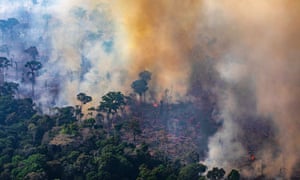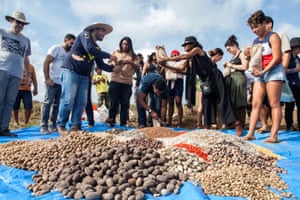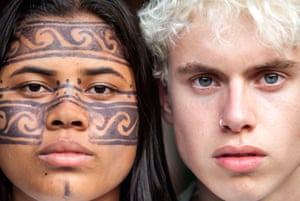Extract from The Guardian

Main image: Brazil’s National Institute of Space Research said the number of fires detected by satellite in the Amazon region in August was the highest since 2010. Photograph: Victor Moriyama/Getty Images
A diverse band of river communities, activists and academics are
meeting in the heart of the rainforest to fight for the planet’s future
by Jonathan Watts Terra do Meio
by Jonathan Watts Terra do Meio
On
the six-hour boat ride down the Iriri river to Manolito, there is
almost no other traffic and only a handful of small homes. At its widest
and calmest, the vast expanse of water is a flawless mirror of blue sky
and green canopy. At its narrowest and roughest, the water churns
around boulders eroded into the shapes of battlements and breaching
whales. Parrots fly above the treetops. Fish feast on fallen blossoms.
Kingfishers perch on riverside branches while herons await their prey on
midstream rocks with their wings outstretched. White and yellow
butterflies stumble across the river at remarkable speeds.
It is in this idyllic setting, deep inside the Amazon rainforest,
that a nascent alliance of traditional communities, climate activists
and academics is re-imagining what the world’s greatest forest was, what
it can be and who can best defend it.The gathering in Manolito, a riverine community of half a dozen wooden buildings in Terra do Meio (Middle Earth), contrasts sharply with what is happening elsewhere in the rainforest. Manmade fires continue to ravage swathes of Brazilian land. Scientists say the forest must be protected if the world is to avoid dangerous levels of global heating, yet the government of the far-right president Jair Bolsonaro has given the green light to farmers, miners and loggers to enter the region and cut down trees. The results will be apparent on Monday, when the government releases the latest annual deforestation figures.
The forest’s traditional guardians – indigenous, riverine and quilombola (descendent of rebel slaves) communities – are expecting the worst and starting to fight back. Forging new alliances with young activists from Europe, they hope the connections will lead to more international support and greater overseas prominence for their long struggle to defend their land against invasion.
The line-up in Manolito is eclectic. Extinction Rebellion organisers from the UK and school climate strikers from Belgium have worked alongside Nadya Tolokonnikova from the Russian feminist punk band Pussy Riot, learning about the forest’s history and role, and sharing ideas on how to defend it.
To get here, the participants travelled through the indigenous territory of Cachoeira Seca, which has been invaded by so many land-grabbers and illegal miners that the small population of Arara Indians are outnumbered 10 to one in their own land. This leaves them powerless to stop further intrusions. Anthropologists say they are now among the most endangered tribes in Brazil.
There are other traditional forest dwellers looking for new allies, as they face the most hostile government since the military dictatorship that ended in 1985. The indigenous shaman and figurehead Davi Kopenawa Yanomami sees hope in the youth climate movement that has spread across the world in the past year. “It’s a new way of thinking and it’s very strong. The young from the cities are listening to the cry of the Amazon. They see the fire and the deforestation and they know that you can’t keep killing trees,” he said. All the world is talking about the Amazon. It’s very good. The new generation wants to save the life of the forest and the planet.”

A key objective of the gathering – which is seen as a Forest COP – is to show that much of what the outside world believes about the Amazon is wrong. That it is more central to planetary life-support systems than most people realise. As well as being home to the richest biodiversity, and sequestering more carbon dioxide than any other land region, it is also a vital part of the planet’s cooling system.
The meeting room doubled as a classroom. Conditions were basic – half a dozen wooden benches, four tables and a blackboard – but the lessons were cutting-edge: several of Brazil’s leading academics shared groundbreaking research on climate science, anthropology and archeology that upturned the popular history of the Amazon as an uninhabited, disease-ridden wilderness civilised by European colonialists and their descendants.
The rainforest functions as the heart of the world, according to Earth scientist Antonio Nobre. Even more than sucking CO2 out of the atmosphere, the forest’s most crucial role is to pump water – the blood of the planet – through rivers and across the skies in the form of vapour, he says. This is done by the transpiration of billions of plants. Over time, satellite data of the world’s photosynthesis (essentially the green areas seen from space) shows the most regular pulse across the tropics, with by far the most vibrant beat in the Amazon. “When we are hot, we sweat. The forest does this – pushing 20bn tonnes of water vapour into the atmosphere each day. It’s part of the cooling system of the world,” said Nobre. “The relationship between the forest and water is extremely important.”
This is nature at its most vibrant and super-diverse – but the forest is also far less wild than many realise. Brazil’s leading archeologist, Eduardo Neves of the University of São Paulo, came into the gathering with a ceramic fragment and a handful of black soil he had picked up outside. This, he said, was a sign the forest in this area was cultivated.
This was remarkably sustainable. For about 10,000 years, the indigenous residents of the forest cleared less than 0.5% of the Amazon while planting productive trees that enriched the soil and increased biodiversity, Neves said. The population thrived, reaching at least 8 million before European colonialists arrived, bringing diseases such as malaria, influenza and measles that – along with slavery and violence – wiped out 90% of the Amazon’s indigenous population.

Maria do Socorro Silva, a quilombola leader from Barcarena, is opposing a mine – powered by the Belo Monte dam – and a Norwegian-owned alumina processing factory. “The company destroyed everything. They took my past and my future,” she told the meeting. “The river is poisoned. Future generations are born dead. The people of the forest aren’t protected. We decided to sacrifice our generation. We eat our poisoned food, but we don’t sell.”
Without them, the forest is more vulnerable. More than cattle or soy, the biggest single driver of deforestation is land-grabbing for property speculation. Scarcely a tenth of the cleared land is put to use. Clearing forest increases the value of land 50- to 100-fold. With so much at stake, anyone standing in the way is dangerous, which is perhaps why only those with an attachment to the land are willing to risk their lives.
Mauricio Torres, a social scientist at the University of Pará, said it was no coincidence that deforestation stopped at the borders of indigenous territory and the extractive reserves of indigenous people. It’s not because the state is protecting those areas but because the residents defend their land. That’s also why these areas have the highest murder rates,” he said in a talk after a dinner of locally produced food. “The only reason this area is still beautiful is because of the victories of the local riverine people who fought for it. I’ve been studying this most of my life, and what I have learned is the best way to protect the forest is to support the traditional families who live there.”
To do this, some participants at the meeting proposed an international boycott of products that degrade the Amazon, such as soy and beef, and greater promotion of sustainable native fruits, such as acai and cupuaçu. Others said nature – particularly the rainforests – should be put at the heart of discussions at the United Nations climate talks that will be held in Madrid next month. Other plans will be discussed at greater length at a bigger civil society meeting in Altamira.
Some of the European visitors said they were already revising how they see climate action. “The people of the forest and the forest itself completely depend on each other. This has changed the way I think. It’s not man and nature. They depend on each other. They can thrive together. That’s the big thing I will be taking back. The problem is not humans, it is the system,” said Alejandra Piazzolla, an XR Youth campaigner who recently graduated from university.
Tiana Jacout, an Extinction Rebellion organiser from Somerset, said she would urge the organisation to include global justice among its demands. “The Amazon now feels really, really personal. It’s impossible to come here and not fall in love with the forest and the river and the people. And it is impossible to think that anyone would destroy that.”
Land-grabbers
The biggest single driver of deforestation is property speculation. Wealthy individuals from faraway cities such as São Paulo, Rio de Janeiro and Curitiba hire grileiros (land-grabbers) to invade and clear the forest, then bribe officials to secure ownership rights. The value of the land increases 50- to 100-fold. Most of it goes unused.Mining
Tens of thousands of garimpeiros (illegal miners) clear forest and poison rivers while prospecting for gold. Even greater damage is done by corporate mega-mines, such as the one being planned at Belo Sun.Logging
The vast majority of timber in Brazil is cut illegally. The forest trails opened by loggers are often later used as access routes by land grabbers.Farming Cattle ranching has devastated the Amazon as trees are cut down to create pastures. Soy monocultures are an increasing threat, particularly in the south. Many of these products are sold in Europe, the US, China and Japan.
Infrastructure projects
Since the military dictatorship began building the Trans-Amazonian highway in the 1970s, deforestation has increased. As well as other roads, hydroelectric dams are submerging more forest and bringing more people to the region.
No comments:
Post a Comment